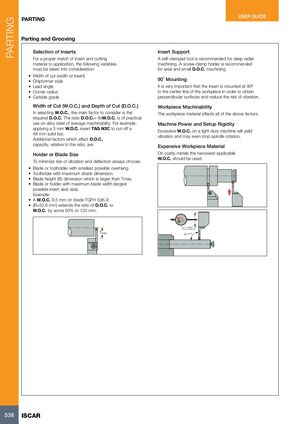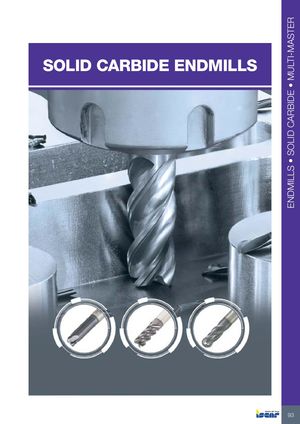Каталог Iscar отрезка 2022 - страница 80
Навигация

PARTING 10 200 3090 4080 5070 60 PARTING USER GUIDE Parting and Grooving Selection of Inserts Insert Support For a proper match of insert and cutting A self-clamped tool is recommended for deep radial material to application, the following variables machining. A screw-clamp holder is recommended must be taken into consideration: for axial and small D.O.C. machining. • Width of cut (width of insert) • Chipformer style 90˚ Mounting • Lead angle It is very important that the insert is mounted at 90º • Corner radius to the center line of the workpiece in order to obtain • Carbide grade perpendicular surfaces and reduce the risk of vibration. Width of Cut (W.O.C.) and Depth of Cut (D.O.C.) Workpiece Machinability In selecting W.O.C., the main factor to consider is the The workpiece material affects all of the above factors. required D.O.C. The ratio D.O.C.≈ 8xW.O.C. is of practical use on alloy steel of average machinability. For example, Machine Power and Setup Rigidity applying a 3 mm W.O.C. insert TAG N3C to cut-off a48 mm solid bar.Additional factors which affect D.O.C.Excessive W.O.C. on a light-duty machine will yieldvibration and may even stop spindle rotation. capacity, relative to the ratio, are: Expensive Workpiece Material Holder or Blade Size On costly metals the narrowest applicable To minimize risk of vibration and deflection always choose: W.O.C. should be used. • Blade or toolholder with smallest possible overhang. • Toolholder with maximum shank dimension. • Blade height (B) dimension which is larger than Tmax. • Blade or holder with maximum blade width (largest possible insert seat size). Example: • A W.O.C. 9.5 mm on blade TGFH 53K-9 • (B=52.6 mm) extends the ratio of D.O.C. to W.O.C. by some 50% to 120 mm. 0.1/1000 Tmax 90°±10' 538 ISCAR
 Каталог Iscar монолитные фрезы 2022
Каталог Iscar монолитные фрезы 2022 Каталог Iscar резьбонарезные фрезы
Каталог Iscar резьбонарезные фрезы Каталог Iscar расточные системы
Каталог Iscar расточные системы Каталог Iscar токарный инструмент 2017
Каталог Iscar токарный инструмент 2017 Каталог Iscar инструмент для фрезерования
Каталог Iscar инструмент для фрезерования Каталог Iscar высокоточные развертки и метчики 2022
Каталог Iscar высокоточные развертки и метчики 2022